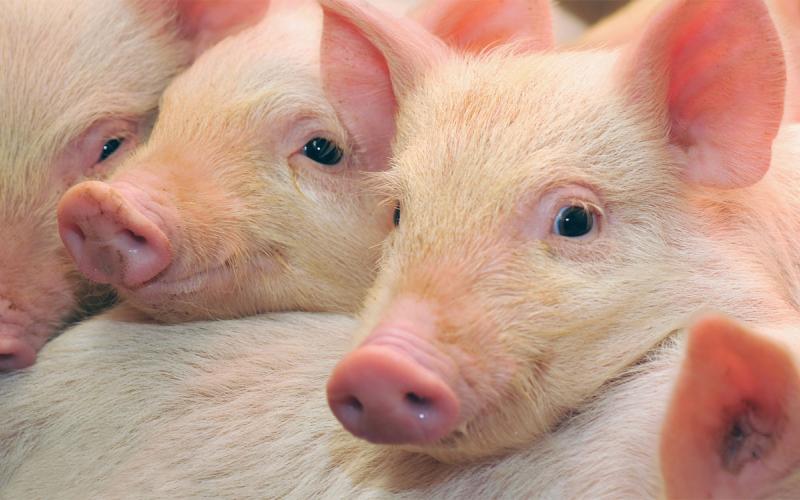
Written by Ryan Samuel, former SDSU Extension Swine Specialist.
The newly weaned pig presents some unique challenges for swine producers. Transitioning piglets from the farrowing room to the nursery or wean-to-finish barn are important foundational steps towards producing full-market value finisher pigs. Dietary, environmental and social changes occur abruptly and can significantly challenge piglets. Things that can be controlled related to weaning include age, diet, feed and water quality and access, and the barn environment.
Weaning Age
Weaning age is important to the success of the weaned pig. For example, piglet antibody protection gradually wanes from the moment the pig receives immunoglobulins from the sow’s colostrum shortly after birth through approximately 3 weeks of age. In fact, when weaning at 3 weeks of age, the initial antibody protection from colostrum has faded, and the piglet is still developing their own adaptive immune response system. At the same time, the digestive system and digestive enzyme production of the piglet are developing. For example, protease, amylase, maltase and sucrase production steadily increase after about 4 weeks of age, whereas lactase production sharply decreases. These changes in enzyme production profile help piglets transition from milk to grain diets. The dietary and management strategies employed to optimize nutrient utilization and promote animal health may depend on the weaning age of the piglet.
Feed and Water
Specialized diets for weaned pigs are expensive because of the feed ingredients they contain. Highly digestible feedstuffs are typically so, because the processing involved to improve digestibility adds cost. For example, soy protein may be hydrolyzed or fermented to produce products for nursery pig diets with higher cost than the unaltered soy protein. Specialized diets have been shown to transition piglets more-effectively from the liquid diet of sow’s milk to dry diets of grains. However, the cost of the diets needs to be balanced against the performance goals for the pigs in the nursery, because any growth benefits do not necessarily translate to improvements in grow-finish performance. Providing high-quality feeds containing ingredients with high nutrient values and feed and water devoid of contaminants is critical to the success of newly weaned pigs.
Feed must be provided fresh, and strategies that increase intake can improve weaned pig growth performance and health. During lactation, piglets nurse quite frequently (~16 to 20 meals per day). Comparatively, even though they have free access to feed, weaned pigs eat infrequently, often visiting the feeder only once per day. Providing small amounts (0.5 lbs./20 pigs) on mats at least two times per day for the first week can help piglets transition to feed. At the same time, feeders should be adjusted to provide 2/3 feeder pan coverage. Piglets must find food and water within 36 hours of weaning, or else they are unlikely to survive. Gruel feeding can be used to help any pigs that appear to be dehydrated and/or not eating. The mix of feed and water (typically 60% feed and 40% water) can encourage piglets to eat and drink. The gruel could be made available in a small feeder or even provided via syringe to specific piglets. Water flow rate from water nipples can influence water consumption and should be adjusted to provide 1 cup/minute for pigs from weaning to 25 lbs. and 2 cups/minute thereafter. Furthermore, if using water nipples, the height should be adjusted to shoulder high on the smallest pig. Waterers should be tied open, or water provided in water bowls for the first 3 or 4 days after weaning to encourage piglets to drink. Providing unrestricted access to fresh feed and water is essential, and proper management can encourage intakes and, therefore, growth.
Barn Environment
The barn environment will also influence animal growth and wellbeing. Weaned pigs in the summer may benefit from high outdoor temperatures; however, it is vice versa when it comes to starting weaned pigs in the winter. Barn temperature should be set so that heaters work in conjunction with supplemental heat from brooders to provide pigs a warm environment between 85 and 89 °F while piglets are adjusting to their new surroundings. If mats are used, they must be kept clean and dry to effectively absorb heat and provide a warm microenvironment. At the same time, sufficient air movement must be maintained to keep humidity below 65%. The barn temperature may be gradually reduced automatically by the fan controller temperature curve to optimize the environment according to research and experience as the pigs age. However, it is important to observe pig behavior. For example, seeing pigs laid next to each other is a sign when pigs are comfortable. Alternatively, pigs will spread out away from each other if the barn environment is too hot, or pile on top of each other if the barn environment is too cold. Controlling the barn environment, including temperature and humidity and according to the needs of the pigs, is fundamental to ensure successful transition of newly weaned pigs.
In Summary
Weaned pigs go through a stressful time moving from the farrowing room to the nursery or wean-to-finish barn. Their diet, environment, and social structure changes abruptly through weaning. Increasing weaning age, providing diets prepared with high quality and high nutrient feedstuffs, water without contaminants, encouraging feed and water intake, and managing the barn environment are all factors that can improve the success of the newly weaned pig.
For more information, contact Ryan Samuel. This information was presented in Webinar #4-Nursery Pig Management.


